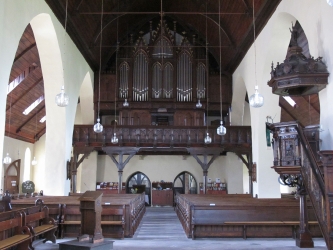Sample set Sonus Paradisi - Piacenza - Organo di Padre Davide
Jetzt kaufen: 335.00 CHF
Variante surround à 6 canaux de l'orgue virtuel romantique italien de l'instrument du Padre Davide à Piacenza (Italie).
Chiffré, protégé par dongle, Hauptwerk v.5 ou supérieur requis.
Beschreibung
The Serassi organ (1825-38) of S. Maria of Campagna in Piacenza
The organ of the church in Santa Maria of Campagna in Piacenza (Saint Mary of Campagna located in Piacenza, Italy) was manufactured by the Serassi Brothers from Bergamo in two periods (1825 and 1838) under the supervision of Father Davide from Bergamo, the organist of the church and a noted composer of the period ("Padre Davide da Bergamo").
This organ is one of the most important Italian instruments due both to the fame of its makers (Serassi was the most popular manufacturer of organs in that period) as well as for the stop disposition and sound characteristics specifically wanted by Padre Davide. It fully reflects the orchestral taste of Italian organ music in the 1800s.
Thanks to the Serassi Brothers (and to Bossi, their rival/colleagues), beginning in the mid 1700s the small Italian organ started to gain an enrichment from new sounds intended to imitate instruments in the orchestra: the transverse flute (or Flutta), the English horn, the hunting horns, the trumpet, the bassoon, the piccolo, the cello, etc. To these pipe sounds were also added percussion effects like timpani, bells, and the bass drum (Turkish band).
All this additional color was obtained even while leaving the general dimensions quite small, especially if compared to contemporaneous organs outside Italy. This efficiency was accomplished due to the extensive use of "half registers." These stops did not play on the full keyboard, but only in the bass or treble half. In this way, pipe space was saved by offering to the organist the the use of two different registers simultaneously in the left and right hands.
The total effect was remarkably evocative of a real orchestra or band. On the organ it was therefore possible to play not only the religious repertoire for services but also secular pieces, ranging from orchestral to theatrical music, including sonatas, symphonies, and other freely-composed pieces. Italian music written for use in the liturgy (offertories, elevations, post-communion voluntaries, and versets) changed in style, becoming more brilliant and virtuosic. The organist was no longer a "mere servant" of the liturgy but instead became virtuoso: a concert player in the modern sense. In this process of organ and musical evolution, Padre Davide from Bergamo played a fundamental role.
Padre Davide was born in Zanica (just south of Bergamo) on January 21, 1791, under the name of Felice Moretti. He began organ study in 1806 with Davide Bianchi and continued later with Antonio Gonzales. He took composition lessons from Johann Simon Mayr. He was organist in various locations near Bergamo (Torre Boldone, Zanica, and Gandino). On July 25, 1818, Padre Davide took religious orders and joined the minor friars convent of S. Maria di Campagna in Piacenza, where he stayed for 45 years until his death in 1863.
During these years, Padre Davide wrote a large quantity of organ and vocal music (for the chorus of the friars of the basilica). He was highly sought-after throughout Italy to play for the dedications of new organs and was a true concert player, the first organist in a period that saw many virtuosi on other instruments (Viotti, Paganini, Bazzini, Bottesini, Carulli, Sivori). His activity was very intense: hundreds of concerts and active participation in numerous organ projects as a performer and consultant.
When Padre Davide arrived in Piacenza, the organ of the Basilica was a modest eighteenth century instrument by Cavalletti. Soon thereafter, Padre Davide began contact with the Serassi Brothers to seek an expansion of the old organ. The work was performed in two phases: a first stage in 1825 followed by the inclusion of the second manual in 1838.Selected pipes of Cavalletti were reused into the Organo Eco. Some of the pipes are probably even older, coming from the Giovanni Battista Facchetti who built the very first organ of the church around 1528.
In addition to the usual orchestral registers, Padre Davide wanted to include a unique special effect: the bells. These are real bells (an octave) which can be played in different ways, in the manuals or with the pedal. In occasion of the inauguration of the great instrument, Padre Davide wrote 15 organ pieces, published by Ricordi in 1838.
1. Manual (Organo Eco) c0–c4
enclosed in a swell box
Principale8'
Ottava bassi4'
Ottava soprani4'
Quintadecima2'
Decimanona1 1/3'
Vigesimaseconda1'
Due di Ripieno2x
Flauto in VIII soprani 4'
Violoncello soprani16'
Arpone bassi16'
Tremolo Eco
Campane di armonia
(soft bells, c1-c2)
2. Manual (Grand'Organo) FF–c4
Principale bassi16'
Principale soprani16'
Principale bassi8'
Principale soprani8'
Principale II bassi8'
Principale II soprani8'
Ottava bassi4'
Ottava soprani4'
Ottava II4'
Duodecima2 2/3'
Quintadecima2'
Decimanona1 1/3'
Due di Ripieno I2x
Due di Ripieno II2x
Due di Ripieno III2x
Due di Ripieno IV2x
Due di Ripieno V2x
Cornetto I2x
Cornetto II2x
Fagotto bassi8'
Tromba soprani16'
Clarone bassi4'
Clarino bassi2'
Corno Inglese soprani16'
Cornamusa soprani8'
Oboe soprani8'
Violone bassi8'
Viola bassi4'
Violetta soprani8'
Flutta soprani8'
Fluttina bassi2'
Corni da Caccia soprani 16'
Flauto in VIII4'
Flauto in XII bassi2 2/3'
Flauto in XII soprani2 2/3'
Flagioletto bassi1/2'
Ottavino soprani2'
Voce Umana soprani8'
Campanelli soprani
(small bells)
Pedale C–H
Contrabassi e Ottave16'
Timballi in tutti i toni
Timballi in cinque toni
Bombarde16'
Tromboni8'
Campane di voce naturale
(loud bells, C-c0)
Campane di tuba dolce
(soft bells, C-c0)
Couplers:
Terzamano (II/II 4'), enabled either by pulling a drawstop, or enabled by f0 key of the pedalboard. This is the original functionality and modelled so in Hauptwerk.
Unione dei due organi (I/II 8')
Unione Tasto-Pedale (II/P 8')
Unione Controttava al Pedale (II/P 16')
Accessories:
Rollante (a drum). Operation possible via two switches. Either enabled by pulling a Rollante drawstop, or enabled by g0 key of the pedalboard. This is the original functionality and modelled so also in Hauptwerk. Rollante can be voiced (for example to adjust volume) using the Hauptwerk pipe voicing using the appropriate virtual rank (Rollante, Gran Cassa) and the sliders of the key 17 (F). Always disengage and engage Rollante after each voicing attempt to apply the voicing changes. Voicing is not applied to a sounding pipe in Hauptwerk.
Gran Cassa (an orchestra hit) located right of the pedalboard as a foot switch. In addition to that, it can be operated by f#0 key of the pedalboard in Hauptwerk. The pedalboard operation is not original, it is modelled to allow the Gran Cassa operation on those consoles where no proper foot switches are available. Gran Cassa can be voiced using the Hauptwerk pipe voicing using the appropriate virtual rank (Rollante, Gran Cassa) and the sliders of the key 21 (A).
Tiratutti (Principal Plenum combination) - foot switch located right of the pedalboard.
Combinazione libera alla Lombarda - a free combination. Preselect the stops on the dedicated Hauptwerk screen and activate them all at once by pressing the Combinazione libera button. (The action of Combinazione libera is identical to Hauptwerk Master Reversible Combinations.). Only stops of the Grand'Organo may be preselected for Combinazione libera. The preselection of a particular stop is visible on the photorealistic tabs by means of a vertical bar on the left edge of the stop labe. This bar is even clickable to change the combinazione libera directly from the photorealistic tabs in Hauptwerk.
Gelosia Organo Eco (swell pedal) located left of the pedalboard.
Ance al'Organo Grande (on/off switch for all reeds on manuals) foot switch located left of the pedalboard.
Campane switch - enabling the tracker to the bells. When off, the bells do not sound.
Foot switches for some stops available in the form of small latch-down foot pedals, sometimes in addition to drawstops for some characteristic stops. On the real console, these switches are ordered as follows (from left to right): Fagotto bassi, Corno Inglese soprani, Flagioletto bassi, Cornamusa, Campane, Unione dei due Organi, Gran Cassa, Tiratutti.
Möchten Sie diesen Produkt in unserem Showroom sehen?
Füllen Sie einfach dieses Formular aus und wir werden mit Ihnen Kontakt nehmen, um einen Termin zu vereinbaren!






